Church of St Nicholas, Great Wakering
Article by Richard Kirton
With a few exceptions the Norman church of St Nicholas is built of roughly coursed rag stone rubble, some septaria, flint and Roman tile; the corner dressings are of Reigate and other limestone; the roofs are constructed with red plain tiles and the spire is boarded and painted white.
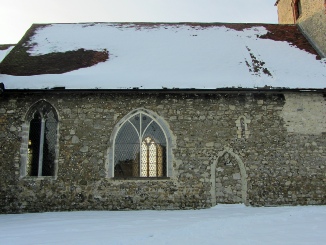 The Nave was built about 1100 A.D. by the Normans. The 14th Century restored eastern window on the North Wall has two trefoiled lights with a two-centred arch and label. The wide central window has a two-centred arch with an inserted 18th Century two-light wooden frame. To the west of this window is a blocked 14th Century Doorway with a two-centred arch together with a small blocked round headed widow higher up but slightly to the west. To the far west and below the eaves is an 18th Century three-light window with a transom.
The Nave was built about 1100 A.D. by the Normans. The 14th Century restored eastern window on the North Wall has two trefoiled lights with a two-centred arch and label. The wide central window has a two-centred arch with an inserted 18th Century two-light wooden frame. To the west of this window is a blocked 14th Century Doorway with a two-centred arch together with a small blocked round headed widow higher up but slightly to the west. To the far west and below the eaves is an 18th Century three-light window with a transom.
The two eastern windows on the South Wall are similar to the eastern window on the North Wall and the partly restored 14th Century window west of the South Porch has of 2 pointed lights, under a 2-centred head and label. The partly restored 14th Century western window has two pointed lights under a two-centred head and label. The mid-13th Century inner Doorway which links the South Porch to the Nave has a two-centred arch with moulded imposts and its timber Door is probably 15th century.
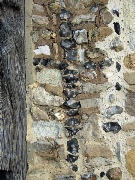 To the right of the Doorway the existing stone niche would once have housed a Holy Water Stoup. On either side of the door is a Scratch Dial incised into the stone doorway uprights as incised circles with lines radiating from a central hole which would have originally contained a peg or pin. These dials would have served as Sun Dials to enable masons to tell the time and they presumably predate the building of the Porch.
To the right of the Doorway the existing stone niche would once have housed a Holy Water Stoup. On either side of the door is a Scratch Dial incised into the stone doorway uprights as incised circles with lines radiating from a central hole which would have originally contained a peg or pin. These dials would have served as Sun Dials to enable masons to tell the time and they presumably predate the building of the Porch.
The South Porch, which was constructed in the early 16th century, consisted originally of timber framing on dwarf rubble walls with roof beams looking remarkably like a ship's timbers. The openings between the timber uprights were filled in later. On either side of the outer archway of the Porch is a ‘Design’, crafted in flint; the design on the west portrays a Fish and the design on the east a Cross.
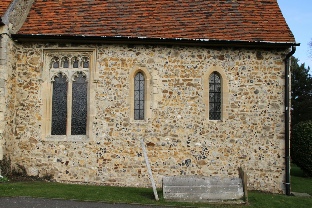 The Chancel was also built around 1100 A.D. by the Normans. The East Wall has an angled buttress to the north angle and Gault bricks (a whitish brick made from Gault clay) in the gable apex. The East window is 19th Century and has three trefoiled ogee lights with tracery over and moulded two-centred arch and label. The south wall has a 15th Century window with two cinquefilled lights with vertical tracery, under a moulded square head and label.
The Chancel was also built around 1100 A.D. by the Normans. The East Wall has an angled buttress to the north angle and Gault bricks (a whitish brick made from Gault clay) in the gable apex. The East window is 19th Century and has three trefoiled ogee lights with tracery over and moulded two-centred arch and label. The south wall has a 15th Century window with two cinquefilled lights with vertical tracery, under a moulded square head and label.
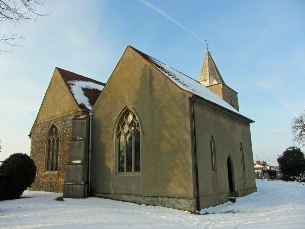 The Lady Chapel on the North side of the Chancel was built of plastered brick in 1843 and dedicated to the Blessed Virgin Mary; the east window has three trefoiled ogee lights with tracery over and two-centred arch and label; the north wall has two lancet windows. The central doorway has a two-centred Arch.
The Lady Chapel on the North side of the Chancel was built of plastered brick in 1843 and dedicated to the Blessed Virgin Mary; the east window has three trefoiled ogee lights with tracery over and two-centred arch and label; the north wall has two lancet windows. The central doorway has a two-centred Arch.
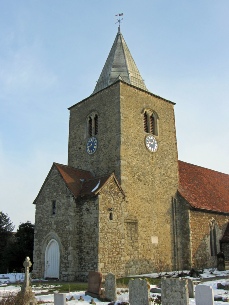 The Norman Tower was built in three stages and is approximately 13½ feet square. The lower stage of the tower was added to the Norman church circa 1130-1140 and was built with angled pilaster buttresses between the West Porch and the Tower. The lower stage of the Tower is used as the vestry. The upper stage was constructed towards the end of the 12th century and was built without buttresses. On the south side of the tower there is a tablet with the words: “The clock in this tower was erected by the inhabitants and Landowners of Great Wakering to commemorate Coronation of King George V, 22nd June 1911. Horace Serjeant (Vicar) Chairman. William H Fry. Hon Secretary”. There are two Clock Faces below the 15th Century South and West Windows on the outside. The north wall has a blocked 12th Century window with a later smaller round headed window set in and to the ground floor a 15th Century window of two cinquefoiled lights under a square head and moulded label. The north, south and west facing stone window frames of the Bell Chamber have two trefoiled lights with segmental heads and labels, and the East facing brick window frame has segmental head and label.
The Norman Tower was built in three stages and is approximately 13½ feet square. The lower stage of the tower was added to the Norman church circa 1130-1140 and was built with angled pilaster buttresses between the West Porch and the Tower. The lower stage of the Tower is used as the vestry. The upper stage was constructed towards the end of the 12th century and was built without buttresses. On the south side of the tower there is a tablet with the words: “The clock in this tower was erected by the inhabitants and Landowners of Great Wakering to commemorate Coronation of King George V, 22nd June 1911. Horace Serjeant (Vicar) Chairman. William H Fry. Hon Secretary”. There are two Clock Faces below the 15th Century South and West Windows on the outside. The north wall has a blocked 12th Century window with a later smaller round headed window set in and to the ground floor a 15th Century window of two cinquefoiled lights under a square head and moulded label. The north, south and west facing stone window frames of the Bell Chamber have two trefoiled lights with segmental heads and labels, and the East facing brick window frame has segmental head and label.
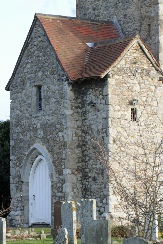 The unusual West Porch has two storeys with gables to the west and the south and was built in the 15th century but in an Anglo-Saxon style with a gabled roof and a projecting wing. The West Porch Doorway inside, has splayed responds and a two-centred Arch and the Plank and Muntin Door leads to the Vestry in the base of the Tower.
The unusual West Porch has two storeys with gables to the west and the south and was built in the 15th century but in an Anglo-Saxon style with a gabled roof and a projecting wing. The West Porch Doorway inside, has splayed responds and a two-centred Arch and the Plank and Muntin Door leads to the Vestry in the base of the Tower.
The octagonal weather boarded Spire has splays at the Tower angles and was probably completed with the Bell Chamber at the top of the Tower in the 15th century. At the request of Trinity House (Government Maritime Authority), the Spire was painted white in 1912 to assist ships navigating the Thames. There are several pairs of initials on the rafters and most with dates: FB 1863, PR 1912, TB (Tom Bailey) 1912, OB 1920, LHB, SB (Saffary Bailey). A new weather vane was fixed to the top of the Spire in 1936 and it was discovered when the spire was repainted in the 1990s that many of the boards were rotten and had to be replaced. Also, some of the ends of the tie-beams which hold up the vertical kingpost through the centre of the Spire were also found to be rotten and Rolled Steel Joists (RSJ) had to be installed for support.
Church Interior
The lower stage of the Norman Tower and West Porch are used as a Vestry and accessed from the Nave through a door behind the Organ. Once in the Tower and looking back east towards the Nave can be seen an early 15th Century highly decorated doorway, showing quite extensive weathering but having the most decorative stonework in the church.
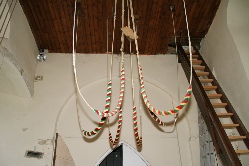 A wooden ladder leads up from the lower stage of the Tower to the Clock Chamber trap door. From there a Spiral Staircase leads on to the Bell Chamber and further steps continue to the top of the Tower. The present peal of six Bells, five of which were recast by Thomas Mears & Sons in 1808, were re-hung and re-dedicated with the dedication of the treble bell by the Bishop of Chelmsford on 1st May, 1948. The weights of the 5 original bells were 4cwt 3qrs 2lbs; 5cwt 2qrs 14lbs; 5cwt 3qrs 8lbs; 7cwt 0qrs 24lbs; and 8cwt 1qr 2lbs. The treble weighs approximately 4cwt 1qr 2lbs. Unfortunately the ringing of the bells had to cease after Easter 1982 for some time, due to considerable structural problems in the tower.
A wooden ladder leads up from the lower stage of the Tower to the Clock Chamber trap door. From there a Spiral Staircase leads on to the Bell Chamber and further steps continue to the top of the Tower. The present peal of six Bells, five of which were recast by Thomas Mears & Sons in 1808, were re-hung and re-dedicated with the dedication of the treble bell by the Bishop of Chelmsford on 1st May, 1948. The weights of the 5 original bells were 4cwt 3qrs 2lbs; 5cwt 2qrs 14lbs; 5cwt 3qrs 8lbs; 7cwt 0qrs 24lbs; and 8cwt 1qr 2lbs. The treble weighs approximately 4cwt 1qr 2lbs. Unfortunately the ringing of the bells had to cease after Easter 1982 for some time, due to considerable structural problems in the tower.
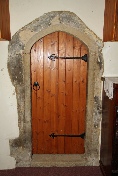 In the West Porch is a staircase to an upper room known as the Priest's Chamber and is thought to have been used by monks from Beeleigh Abbey for overnight quarters whilst preaching in the church. The stained-glass Priest's Chamber window was made and donated to the church by Alistair Bruce in 2000. The exposed timbers in the Priest’s Chamber are very well preserved. To left of the Stair Turret doorway leading to the Priest’s Chamber there is a Medieval Stoup with a moulded head which was rediscovered in 1974 during renovation work. The first floor has a moulded plinth and a square headed window on the west face. There is a small window on the first floor of the South Gable which has a flint band.
In the West Porch is a staircase to an upper room known as the Priest's Chamber and is thought to have been used by monks from Beeleigh Abbey for overnight quarters whilst preaching in the church. The stained-glass Priest's Chamber window was made and donated to the church by Alistair Bruce in 2000. The exposed timbers in the Priest’s Chamber are very well preserved. To left of the Stair Turret doorway leading to the Priest’s Chamber there is a Medieval Stoup with a moulded head which was rediscovered in 1974 during renovation work. The first floor has a moulded plinth and a square headed window on the west face. There is a small window on the first floor of the South Gable which has a flint band.
The Clock was installed to commemorate the coronation of King George V in 1911 and was made by Thwaites & Reed of Clerkenwell, London in 1913. In 1961, the clock was repaired by R J Yeo of Rochford who in 1977 also restored and repainted the dials to commemorate the Silver Jubilee of Queen Elizabeth II. The clock has no springs. The mechanism is controlled by two weights consisting of a series of smaller weights, attached to wires that run out from the clock and down inside the tower in a special wooden casing. As the pendulum swings, the weights gradually descend over seven days, turning the clock's gears. On the seventh day, an appointed winder winds the weights back to the clock and the process begins again.
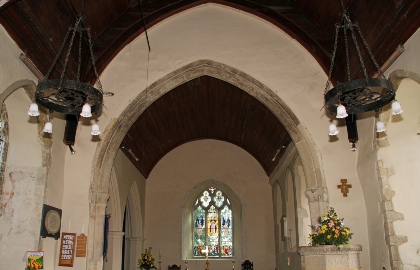 The original Chancel Arch had a round Apse and a small arch but the present lofty English Arch is 15th century with 13th century supports. The Chancel has a boarded barrel vaulted roof and the ceiling was renewed in 1937/8. The large stained-glass window behind the Altar was installed in 1958 as a memorial to Amy Benewith. There are two Sanctuary Chairs behind the Altar, the one on the right being a Victorian reproduction of a William and Mary chair. The Stained Glass Window above the Altar was installed in 1958 as a memorial to Miss Amy Bennewith and represents Christ's Ascension into Heaven.
The original Chancel Arch had a round Apse and a small arch but the present lofty English Arch is 15th century with 13th century supports. The Chancel has a boarded barrel vaulted roof and the ceiling was renewed in 1937/8. The large stained-glass window behind the Altar was installed in 1958 as a memorial to Amy Benewith. There are two Sanctuary Chairs behind the Altar, the one on the right being a Victorian reproduction of a William and Mary chair. The Stained Glass Window above the Altar was installed in 1958 as a memorial to Miss Amy Bennewith and represents Christ's Ascension into Heaven.
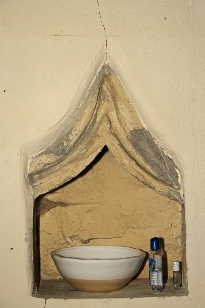 The Piscina in the south sanctuary wall is 13th century with moulded head but the Lavabo Bowl was made in the 1970s. Close by and in the same wall but higher up is an Aumbry with a brass door. The Altar Rail has turned balusters and the 19th Century south Arcade has two bays with capitals and bases to octagonal columns and chamfered two-centred arches. In the floor near the east sanctuary wall is a Slab of Purbeck Marble which once held a monumental brass. In the floor of the Chancel, but now covered, is another Slab of Purbeck Marble with an early 15th century Indent of a priest with a crocketed canopy and an inscription plate. Again the brass is missing.
The Piscina in the south sanctuary wall is 13th century with moulded head but the Lavabo Bowl was made in the 1970s. Close by and in the same wall but higher up is an Aumbry with a brass door. The Altar Rail has turned balusters and the 19th Century south Arcade has two bays with capitals and bases to octagonal columns and chamfered two-centred arches. In the floor near the east sanctuary wall is a Slab of Purbeck Marble which once held a monumental brass. In the floor of the Chancel, but now covered, is another Slab of Purbeck Marble with an early 15th century Indent of a priest with a crocketed canopy and an inscription plate. Again the brass is missing.
The stone Pulpit is Victorian and matched a font that replaced the original Norman font which was destroyed in 1907. This Victorian font was given to a church in North London and the present Font is Norman and was obtained came from the church in East Horndon, Essex around about 1970.
The Lady Chapel extends the seating capacity of the church and there is a board on the Chancel Arch which records its construction. Three bays and two arches with moulded tie-beams and tall octagonal crown posts separate the Lady Chapel from the Chancel has three bays. New chairs were installed in the late 1990s, many of them being donated by local families and dedicated to the memory of their loved ones. New oak furniture pieces were built and installed by Ron Parr in 1997.
The Nave has a seven cant roof of late 14th or early 15th century with three bays that are boarded to the east. Moulded arched braces support the moulded and cambered tie-beam with four armed octagonal crown posts with moulded capitals and bases. The moulded wall posts rest on stone carved corbels, two of them depicting ‘Angels with Wings’ and a ‘Man and Woman’.
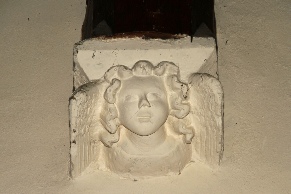 The western pair of supporting stone corbels is late 13th or early 14th century and the eastern pair is later. These had been painted over and resembled wood. In 1907 it was discovered that they were stone and the paint was removed. On the west wall of the Nave and flanking both sides of the Organ are Decalogue Boards with the ‘Ten Commandments’ on the left and the Creed and the ‘Lord's Prayer’ on the right.
The western pair of supporting stone corbels is late 13th or early 14th century and the eastern pair is later. These had been painted over and resembled wood. In 1907 it was discovered that they were stone and the paint was removed. On the west wall of the Nave and flanking both sides of the Organ are Decalogue Boards with the ‘Ten Commandments’ on the left and the Creed and the ‘Lord's Prayer’ on the right.
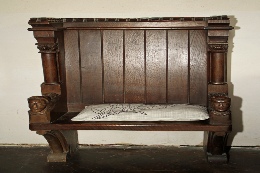 Between the North wall and the Organ is an Oak Parish Chest dating from 1564, which holds recent parish records; earlier records dating back to 1685 are now kept by the Essex Records Office for security and preservation. The Kneelers have all been covered since 1979 with tapestries worked by members of the congregation and their friends. They depict many varied aspects of the church and village, their history and traditions, legends, associations and trades during the last 9 centuries and longer.
Between the North wall and the Organ is an Oak Parish Chest dating from 1564, which holds recent parish records; earlier records dating back to 1685 are now kept by the Essex Records Office for security and preservation. The Kneelers have all been covered since 1979 with tapestries worked by members of the congregation and their friends. They depict many varied aspects of the church and village, their history and traditions, legends, associations and trades during the last 9 centuries and longer.
The 15th Century Rood Stairs, which were re-discovered in 1870, are on the north side of the Nave. These would presumably have led to a loft above the rood screen. There is a piece of timber set in the splay of the north-east window that may have formed part of the rood loft. In the same window recess there are traces of a wall painting, thought to date from the 15th century, which was exposed in 1974 during renovation work. It is believed to represent the Annunciation, and a dove (the Holy Spirit?) can be seen on the right. On the North West wall there is a monument to Elizabeth Peart, dated 1832 and to the east of the North Doorway there are traces of a 17th/18th Century Painted Inscription “Come unto me all ye that are heavy laden".
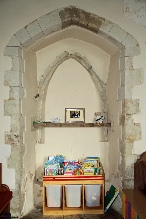 The present Organ was installed in 1964, but was bought from another church and rebuilt at St Nicholas. Brian Fletcher, who has been the organist there for over 25 years, was told that this was at the instigation of the Rev. Paul Faunch, who was a keen musician himself. The organ was re-situated because this was judged to be an acoustically superior position, but it meant that bridal processions could no longer go straight through the tower, through the doorway which is now obstructed by the organ, and up the aisle. It also created quite a separation between organist and choir.
The present Organ was installed in 1964, but was bought from another church and rebuilt at St Nicholas. Brian Fletcher, who has been the organist there for over 25 years, was told that this was at the instigation of the Rev. Paul Faunch, who was a keen musician himself. The organ was re-situated because this was judged to be an acoustically superior position, but it meant that bridal processions could no longer go straight through the tower, through the doorway which is now obstructed by the organ, and up the aisle. It also created quite a separation between organist and choir.
The original organ situated in the Lady Chapel arch was an entirely different instrument, with a somewhat more modest specification. Brian has details of its specification, recorded by local musician and teacher Gerald Usher during a visit to the church in the 1950s. Gerald cycled round the whole of Essex as a teenager, visiting every church on his travels and looking at/playing the organ while he was there - his notebook is quite a valuable historical document!
The North Doorway was exposed in 1974 and a timber door, probably the original one, was discovered but unfortunately it was not possible to preserve it. The Tower Arch behind the organ was built about 1126. It is semi-circular with chamfered imposts. The wall was thickened when the tower was added. Above this arch is a blocked Norman Window of circa. 1100.
Rectors and Vicars
Clergy Qualifications
A.K.C. - Associateship of King’s College
A.L.C.D. - Associate of the London College of DivinityB.A. - Order of Basilians of Aleppo of the Melkites
B.D. - Bachelor of Divinity
L. Mus. - Licentiate in Music
L.Th. - Licentiate in Theology
M.A. - Magister Artium ("Master of Arts")
S.T.B. - Sacrae Theologiae Baccalaureus ("Bachelor of Sacred Theology")
Sources
- English Heritage.
- RCHM (Royal Commission on Historical Monuments).
- Personal visit by Richard Kirton on 15th February 2012.
- Photographs - Richard Kirton
- Church Organ Heritage - Brian Fletcher - Organist for over 25 years.





